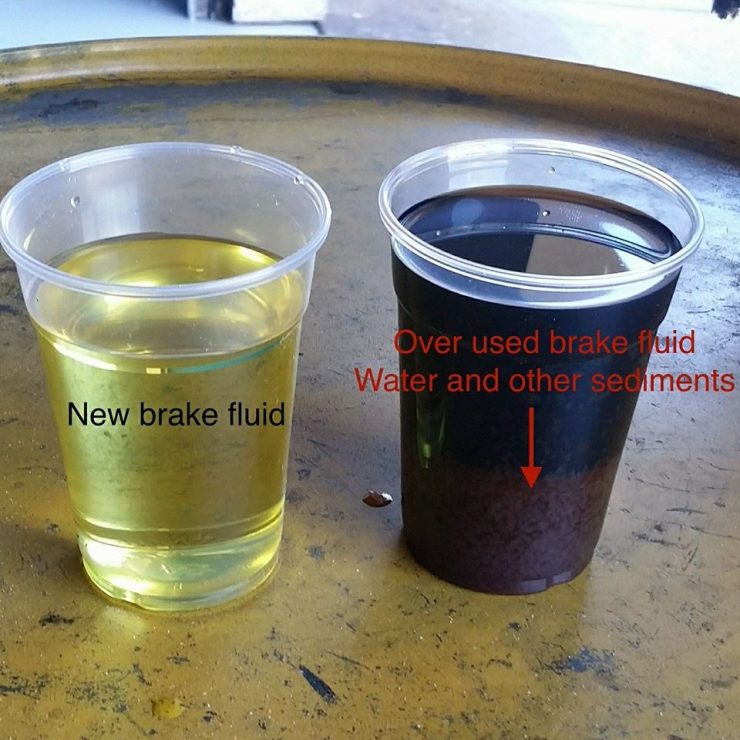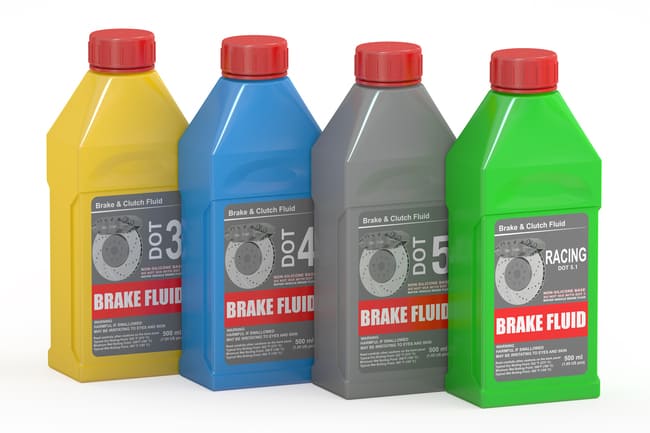Let’s dive a little deeper in the vital role brake fluid plays in ensuring the safety and effective performance of our car’s braking system.
But, before anything is said and done, please know this: brake fluid, while indispensable for vehicular safety, possesses certain chemical properties that make it harmful to car paint and plastic components. Whether you’re a DIY enthusiast, a professional mechanic, or a car owner, being cautious about spills and splashes is essential.
The braking system – how it works, what does the brake fluid do?
At its core, a vehicle’s braking system is designed to slow down or stop the motion of the vehicle safely and efficiently. This system is made up of several components, including the brake pedal, master cylinder, brake lines and hoses, brake calipers or wheel cylinders, and brake pads or shoes.
The braking system basically consists of a chain of events that happen when the driver presses the brake pedal:
- The brake pedal activates the master cylinder, which contains brake fluid.
- The master cylinder then pushes the brake fluid through the brake lines and hoses to reach the brake calipers (used in disc brake systems) or wheel cylinders (used in drum brake systems).
- The hydraulic pressure created by the fluid causes the calipers to squeeze the brake pads against the brake rotors or the wheel cylinders to push the brake shoes against the brake drums. This friction slows or stops the wheel’s rotation.
So what is the role of Brake fluid? Brake fluid is the unsung hero in this sequence. It serves as the hydraulic medium that transmits the force from the pedal to the brakes.
If we were to remove the brake fluid from this chain of events two things would happen:
a. The hydraulic transfer of force wouldn’t occur, rendering the brakes non-functional.
b. The brakes would lack the necessary pressure to create friction and stop the vehicle.
Brake fluid is specially formulated to withstand varying temperatures (from cold starts to the heat generated during heavy braking) and maintain its consistency. Its hygroscopic nature means it can absorb moisture, which is crucial to prevent condensation in the system but also requires periodic replacement as moisture-laden fluid can degrade system performance.
So… yes, brake fluid is important! It is pivotal to the entire braking process. Without it, or with it compromised, the safety and performance of the braking system are at risk. Regular maintenance ensures it remains in optimal condition to support the critical function of stopping the vehicle.
What is brake fluid?
Brake fluid is a type of hydraulic fluid used in hydraulic brake (and hydraulic clutch) applications in automobiles, motorcycles, and some bicycles.
It is a non-compressible substance that is designed to transmit the force exerted at the beginning of the hydraulic system (when the brake pedal is pressed) to the other end, facilitating the braking action.
The main function of brake fluid is to transfer the mechanical force (or pressure) from the brake pedal to the brake calipers and/or wheel cylinders to slow down or stop the vehicle. Due to its incompressible nature, brake fluid effectively transfers this force through the brake lines, ensuring a responsive and reliable braking action. Additionally, brake fluid is formulated to have a high boiling point to resist vaporizing, which could introduce compressible gas bubbles into the braking system, compromising its performance. The fluid also serves as a lubricant for certain brake system components and aids in preventing corrosion within the system.
Brake fluid deteriorates over time. Why?
Brake fluid, especially the commonly used DOT3, DOT4, and DOT5.1 types, is hygroscopic.
This term “hygroscopic” means that the brake fluid has an inherent ability to attract and absorb water molecules from its surroundings, especially from the atmosphere.
Why is it Hygroscopic?
Well, here are the benefits:
- Preventing Vapor Lock: By absorbing water, brake fluid ensures that no small pockets of pure water form within the brake system. This is crucial because pure water has a much lower boiling point than brake fluid. If pure water were present, it could boil under heavy braking, forming vapor. This vapor is compressible, unlike the brake fluid, which could lead to vapor lock – a condition where the brake pedal feels spongy and braking efficiency is reduced.
- Corrosion Prevention: Any moisture that enters the braking system can cause corrosion of metal components over time. By absorbing this moisture, brake fluid helps minimize the risk of corrosion.
And the drawbacks:
- Degradation Over Time: As the brake fluid continuously absorbs moisture over time, its boiling point starts to decrease, reducing its effectiveness and possibly leading to vapor lock. High water content in brake fluid can also accelerate wear and corrosion in the braking system.
- Periodic Replacement Needed: Due to its ability to absorb moisture, brake fluid needs to be replaced at regular intervals to ensure optimal performance and safety. Most manufacturers recommend checking the water content of brake fluid annually and replacing it every two years or so, depending on the vehicle’s use and the specific type of brake fluid.
Signs Your Brake Fluid Needs Changing
- Discoloration: Brake fluid is usually a clear, amber, bluish, red, or greenish color when it comes out of the container and it’s new in the system. If it turns dark brown or murky, it’s a sign of contamination, and it may be time for a change.
- Spongy or Soft Brake Pedal: If the brake pedal feels spongy or softer than usual when pressed, it can indicate the presence of air or moisture in the brake lines, suggesting the need for a brake fluid change.
- Brake Warning Light Activates: In some modern vehicles, the brake warning light on the dashboard will illuminate if the system detects an issue with the brake fluid, among other potential brake problems.
- Slow Brake Response: If the brakes don’t engage immediately after pressing the pedal and there’s a noticeable lag in response, it could be due to degraded or contaminated brake fluid.
- Brake Fluid Level Drop: A consistent drop in brake fluid level in the reservoir could indicate a leak in the system. While this primarily signals the need for a brake system check, it’s also an opportunity to change and top up with fresh brake fluid.
- Odd or Burning Smell: If there’s a strange smell, especially a burning odor when braking, it could indicate overheated brake fluid. Overheated brake fluid can decrease its effectiveness.
- Vehicle Age and Mileage: If you haven’t changed the brake fluid in two years or longer, or if you’ve reached the manufacturer’s recommended mileage for a brake fluid change, it’s time to replace it. Brake fluid naturally degrades over time, even if there aren’t noticeable symptoms.
- Corrosion in the Brake System: Upon inspection, if a mechanic finds signs of corrosion in the brake system components, it’s likely due to moisture-laden brake fluid and suggests a need for a change.
- Vibration or Pulsation When Braking: While this can be due to various issues, such as warped rotors, it can also suggest that the brake fluid is not effectively transmitting hydraulic pressure.
- Testing Indicates High Water Content: Special testers can measure the water content in brake fluid. A reading of 3% water content or higher indicates it’s time for a brake fluid replacement.

It’s essential to remember that brake fluid plays a crucial role in vehicle safety. Regular inspections and timely maintenance can help ensure that the braking system functions optimally when needed the most.
How to Check and Replace Brake Fluid
You can replace most of the brake fluid yourself! And it will be enough to keep your car safe. And don’t worry, most dealerships do it this way too! I’ve written a guide a while ago and it is still valid.
How to find out what type of brake fluid you need
Brake fluids are categorized based on their chemical composition and performance, especially concerning their boiling points.
Your car’s manual will state what type of brake fluid your car requires. Based on that, here’s what you need to know:
DOT3:
- Chemical Composition: Glycol Ether-based.
- Dry Boiling Point: Minimum of 401°F (205°C).
- Wet Boiling Point: Minimum of 284°F (140°C).
- Compatibility: Can be mixed with DOT4 and DOT5.1 but is not recommended to mix due to reduced performance. Not compatible with DOT5.
- Usage: Common in older vehicles; however, it’s gradually being replaced by higher-grade fluids in newer vehicles.
DOT4:
- Chemical Composition: Glycol Ether-based but contains certain borate esters, giving it a higher boiling point.
- Dry Boiling Point: Minimum of 446°F (230°C).
- Wet Boiling Point: Minimum of 311°F (155°C).
- Compatibility: Can be mixed with DOT3 and DOT5.1, but usually not recommended to mix with DOT3 as it will reduce the performance benefits. Not compatible with DOT5.
- Usage: Common in modern vehicles, including many European cars.
DOT5:
- Chemical Composition: Silicone-based.
- Dry Boiling Point: Minimum of 500°F (260°C).
- Wet Boiling Point: Minimum of 356°F (180°C).
- Compatibility: NOT compatible with DOT3, DOT4, or DOT5.1. Mixing can lead to gel formation and decreased braking performance.
- Usage: Less common in everyday passenger vehicles. Often found in military vehicles, classic cars, and some performance vehicles because it doesn’t absorb water and doesn’t damage paint.
DOT5.1:
- Chemical Composition: Glycol Ether-based, like DOT3 and DOT4.
- Dry Boiling Point: Minimum of 500°F (260°C).
- Wet Boiling Point: Minimum of 356°F (180°C).
- Compatibility: Can be mixed with DOT3 and DOT4. However, for best performance, it’s preferable not to mix. Not compatible with DOT5.
- Usage: Used in some modern vehicles, especially those with ABS systems, because of its high boiling points.

In general, higher DOT numbers (especially when comparing DOT3, DOT4, and DOT5.1) tend to indicate better performance characteristics, particularly concerning boiling points. However, DOT5, being silicone-based, behaves differently and should not be interchanged with the other types.
Conclusion
For the everyday vehicle owner, the main takeaway is the importance of adhering to manufacturer recommendations and ensuring timely maintenance.
So if there is one thing you take away from this article it should be this: know how often to check and check your brake fluid. Is it brownish/black-ish? Replacement needed. It is easy to DIY but nobody is going to care if you just go to your favorite mechanic. Just be safe and make sure you have GOOD brake fluid in your car’s braking system.


Comments are closed.